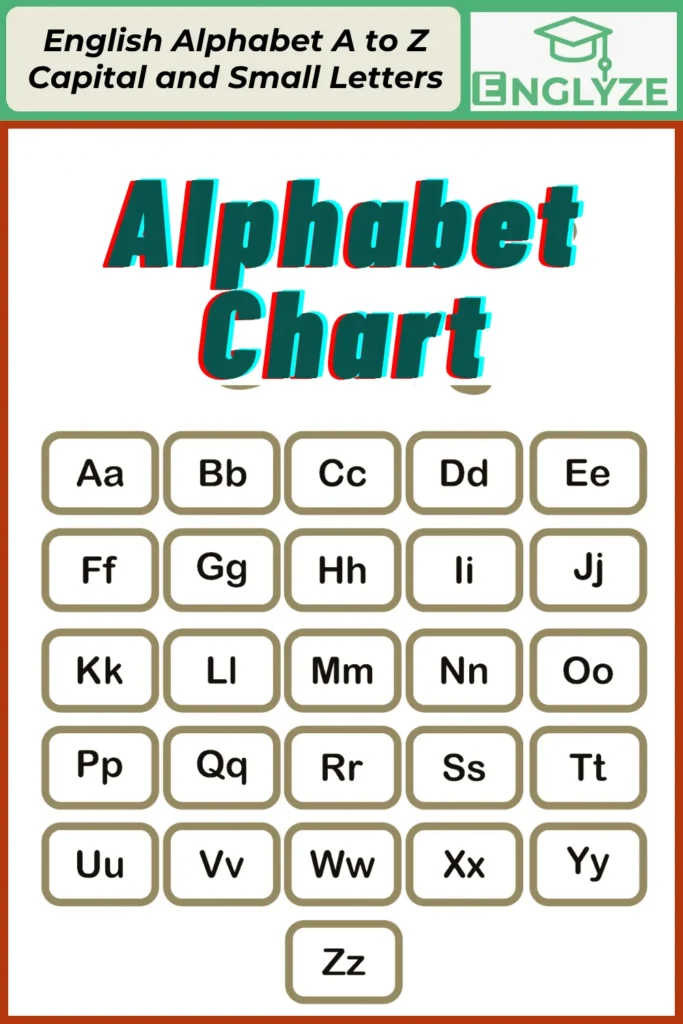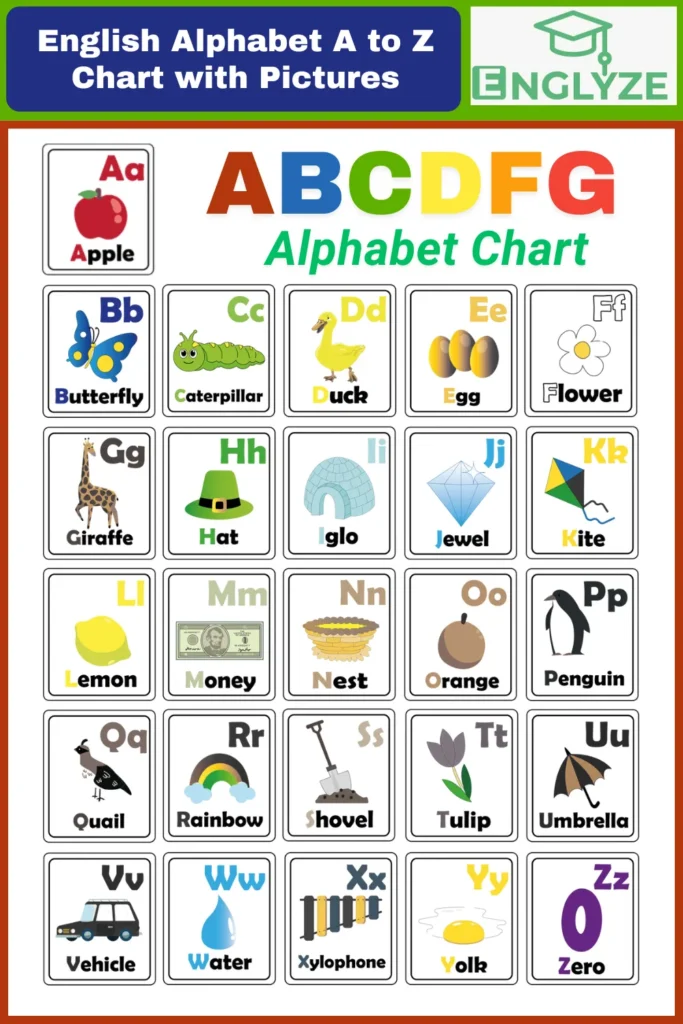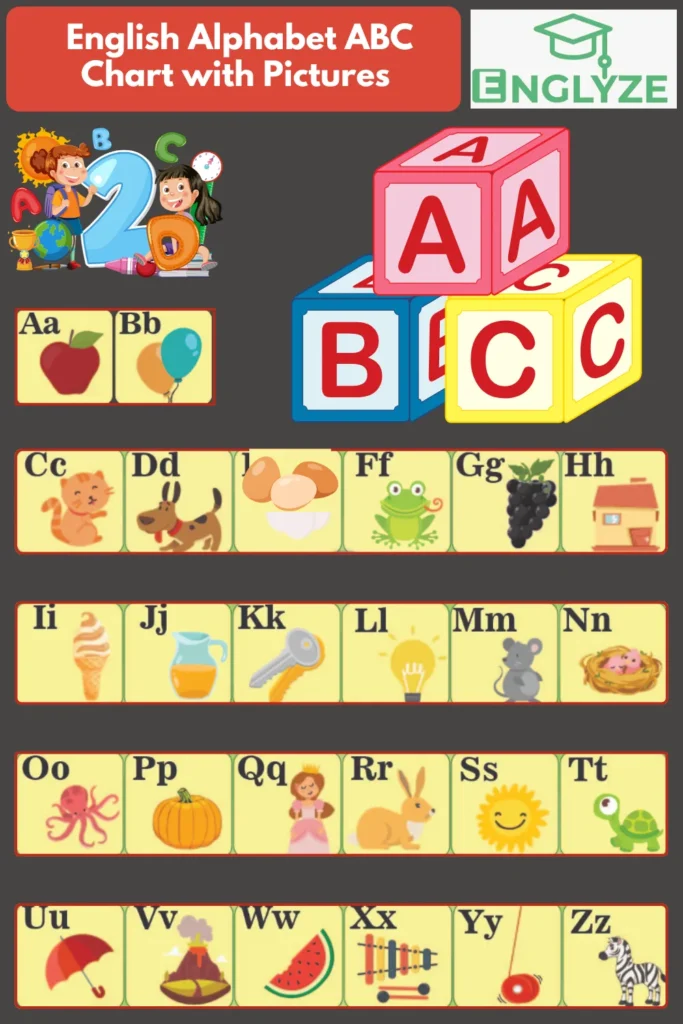The English Alphabets are the foundational building blocks of the English language. Whether you are a beginner or an advanced learner, mastering the alphabet is crucial for enhancing your ability to speak, read, write, and listen in English. Without a strong grasp of the English Alphabets, it becomes difficult to understand how words are formed and pronounced.
In this comprehensive guide, we’ll take you through the essentials of the English Alphabets, from their history to how they work together in combinations. This guide is designed for learners of all ages and proficiency levels, so whether you’re teaching a child or refining your own skills, you will find practical advice and insights here.
Introduction to the English Alphabets
The English Alphabets consist of 26 letters, each of which has its own sound. These sounds can sometimes be tricky, especially when vowels are involved, but once you become familiar with the sounds and their combinations, reading and writing in English becomes much easier.
Understanding these 26 letters — divided into vowels and consonants — is essential in forming words and sounds in English. The letters can be written as either uppercase (capital) or lowercase (small), and each letter has its own distinct name and sound.

Breakdown of the English Alphabets
Here’s a simple breakdown of the English Alphabets:
| Letter | Name | Sound / Pronunciation |
|---|---|---|
| A | Ay | /eɪ/ |
| B | Bee | /biː/ |
| C | Cee | /siː/ |
| D | Dee | /diː/ |
| E | Ee | /iː/ |
| F | Ef | /ɛf/ |
| G | Gee | /dʒiː/ |
| H | Aitch | /eɪtʃ/ |
| I | Eye | /aɪ/ |
| J | Jay | /dʒeɪ/ |
| K | Kay | /keɪ/ |
| L | El | /ɛl/ |
| M | Em | /ɛm/ |
| N | En | /ɛn/ |
| O | Oh | /oʊ/ |
| P | Pee | /piː/ |
| Q | Cue | /kjuː/ |
| R | Ar | /ɑr/ |
| S | Es | /ɛs/ |
| T | Tee | /tiː/ |
| U | You | /juː/ |
| V | Vee | /viː/ |
| W | Double-U | /dʌbəljuː/ |
| X | Ex | /ɛks/ |
| Y | Wy | /waɪ/ |
| Z | Zee / Zed | /ziː/, /zɛd/ |
These 26 letters form the basis of every word in the English language, but how they combine and interact with one another is just as important as memorizing the alphabet.

The Importance of the English Alphabets in Language Learning
The English Alphabets are much more than just a set of 26 symbols. They serve as the foundation for all English words, allowing us to build sentences, express ideas, and communicate effectively. Without understanding these basic units, learning English would be impossible.
Moreover, knowing the English Alphabets helps in reading and writing. When children first start learning, they are taught to recognize these letters, understand their sounds, and associate them with words. For adults and advanced learners, the focus shifts to mastering the more complex rules of spelling and pronunciation.
The diversity and flexibility of the English Alphabets make the language rich, but it can also be challenging. Each letter can have multiple pronunciations depending on its placement within a word or its combination with other letters. For instance, the letter “C” can be pronounced as /k/ in “cat” or as /s/ in “circle.” Mastering these variations is crucial to understanding the nuances of the English language.
Letter Combinations: The Key to Understanding Pronunciation and Spelling
Mastering the English Alphabets is the first step, but learning how these letters combine to form sounds and words is where the true challenge lies. English is filled with letter combinations that change the way letters are pronounced, making it important to understand these patterns. Let’s explore some key concepts such as consonant clusters, digraphs, and vowel combinations.
Consonant Clusters: Combining Multiple Consonants
Consonant clusters are combinations of two or more consonant sounds that appear together in a word without any vowels between them. Understanding how these clusters work is important for proper pronunciation.
Consonant clusters often appear at the beginning, middle, or end of words. Here are some examples:
-
At the beginning of words:
-
str – “street”, “strong”, “stripe”
-
spl – “splash”, “split”, “spline”
-
thr – “three”, “throw”, “thrust”
-
-
In the middle of words:
-
mp – “ample”, “lamp”, “camp”
-
nk – “bank”, “think”, “honk”
-
st – “waste”, “fast”, “past”
-
-
At the end of words:
-
nt – “sent”, “tent”, “plant”
-
nd – “land”, “sand”, “band”
-
ft – “left”, “soft”, “gift”
-
Knowing how to pronounce consonant clusters will help you read and speak English more clearly and confidently.
Digraphs: When Two Letters Make One Sound
A digraph is a pair of letters that together produce a single sound. While individual letters can create different sounds, two letters combined in a digraph will create a unique sound.
Some common English digraphs include:
-
ch – /tʃ/ in “cheese”, “chicken”, “charm”
-
sh – /ʃ/ in “ship”, “shark”, “sheep”
-
th – /θ/ in “thin”, “thank”, “thrust”
-
ph – /f/ in “phone”, “philosophy”, “photo”
Learning these digraphs is essential for understanding English pronunciation, as they appear in many words and can sometimes be difficult for learners to recognize.
Vowel Combinations: Changing Sounds with Pairs of Vowels
Vowels in the English Alphabets can be tricky since they can make a variety of sounds depending on whether they are standing alone or paired with other vowels. Many vowel combinations produce distinct sounds, making it important to learn the patterns.
Some common vowel combinations include:
-
ea – /iː/ in “seat”, /ɛ/ in “bread”
-
ie – /aɪ/ in “pie”, /iː/ in “yield”
-
ou – /aʊ/ in “house”, /uː/ in “through”
-
ei – /eɪ/ in “vein”, /aɪ/ in “height”
-
oo – /uː/ in “pool”, /ʊ/ in “good”
These vowel combinations add complexity to English pronunciation and spelling, but once you learn these patterns, your ability to read and write improves significantly.
Silent Letters: Navigating the Quiet Characters
One of the most challenging aspects of the English Alphabets is the presence of silent letters. In English, certain letters in words are not pronounced at all, which can make spelling and pronunciation difficult for learners. These silent letters often carry historical significance or serve to distinguish words from one another.
Here are some examples of common silent letters:
-
B – in “thumb” /θʌm/, “comb” /koʊm/
-
C – in “muscle” /ˈmʌsəl/
-
D – in “Wednesday” /ˈwɛnzdeɪ/
-
G – in “gnaw” /nɔː/, “sign” /saɪn/
-
H – in “honest” /ˈɒnɪst/, “ghost” /ɡoʊst/
-
K – in “knee” /niː/, “knife” /naɪf/
Understanding where and why these silent letters appear helps learners make sense of the seemingly inconsistent nature of English spelling. Silent letters often reveal a word’s etymology, showing us its historical roots or connections to other languages.

Tips for Learning the English Alphabets
Now that we’ve covered the core concepts behind the English Alphabets, it’s time to look at some practical tips for learning and mastering them.
1. Use Flashcards for Letter Recognition
Flashcards are a great way to practice recognizing both uppercase and lowercase letters. You can even use them to match letters with corresponding words and images.
2. Play Letter-Based Games
Interactive learning is key to remembering the English Alphabets. Games like alphabet bingo, crossword puzzles, or even memory games with letters can help solidify your understanding of the alphabet in a fun and engaging way.
3. Sing the Alphabet Song
Singing the alphabet song is an effective and fun way to remember the sequence of letters. Encourage children or students to sing it regularly to reinforce their memory.
4. Practice Writing Letters
Writing letters by hand helps to solidify their shapes and sounds in your memory. Encourage learners to practice writing letters, both by tracing them and by writing them independently.
The Role of the English Alphabets in Reading and Writing
The English Alphabets are crucial not only in understanding words but also in helping us develop reading and writing skills. In order to become proficient in English, it’s important to recognize how letters combine to form words and how understanding their sounds impacts pronunciation.
When you begin learning English, one of the first things you’ll do is learn how to pronounce each of the English Alphabets. Each letter has a corresponding sound, and when you understand these sounds, reading becomes easier. But understanding the individual sounds of the letters isn’t enough. It’s the way they come together in words and sentences that makes language come alive.
The Importance of Phonetic Awareness
Phonetic awareness is the ability to hear, identify, and manipulate sounds in spoken language. The English Alphabets are based on these sounds, and phonetic awareness is key to learning how letters correspond to sounds.
English learners often find phonetics challenging because many letters have more than one sound. For example, the letter “C” can sound like /k/ in “cat” or like /s/ in “cent.” The ability to recognize these variations is essential for effective communication.
The Connection Between Letters and Sounds
Learning the English Alphabets means understanding not just how letters are shaped or how they are named but how they sound in different contexts. This knowledge helps you with spelling, pronunciation, and reading.
For example, consider the letter “A.” It can sound like /æ/ in “cat,” /eɪ/ in “cake,” or /ɑ/ in “father.” Being able to predict these sounds as you read or write makes it much easier to navigate English.
How the English Alphabets Impact Writing and Spelling
Spelling in English can be complex, and the English Alphabets play a significant role in this complexity. While many languages have consistent spelling rules, English has numerous exceptions due to its diverse linguistic history.
Some words defy standard spelling conventions. For example, the word “through” is spelled with a “th” that makes the /θ/ sound, yet it is not pronounced as a typical “th” sound. In contrast, words like “though” are also pronounced with a “th” sound, but the spelling differs. The key to mastering these irregularities is familiarity with the English Alphabets and their various combinations.
The Role of Silent Letters in Spelling
As mentioned earlier, the English language is filled with silent letters, which can make spelling tricky. Silent letters often appear in words with historical roots. Knowing the English Alphabets and understanding silent letters will help you spell correctly.
For instance, the silent “e” at the end of words like “cake” and “hope” changes the pronunciation of the preceding vowel, as in /eɪ/ instead of /æ/. Similarly, the silent “k” in “knight” is crucial for distinguishing the word from “night.”
Strategies to Master the English Alphabets
Now that you’ve explored the significance of the English Alphabets in reading, writing, and pronunciation, let’s look at some effective strategies to master them. The goal is to build a solid foundation and gradually enhance your skills in using the alphabet in both written and spoken forms.
1. Build a Strong Phonetic Foundation
To truly understand the English Alphabets, it’s important to start with phonetic awareness. Learn the basic sounds associated with each letter and practice blending those sounds to form words. This helps with spelling, reading, and writing.
2. Learn Letter Combinations and Patterns
The English Alphabets are not just about individual letters, but about how they work together. Practice reading common letter combinations like “sh,” “th,” and “ch,” and learn how vowel combinations such as “ea” or “oo” change pronunciation.
3. Practice with Word Families
A word family is a group of words that share a common feature, such as a root word or a pattern. For example, the word family for “cat” includes “bat,” “hat,” “rat,” etc. This helps learners recognize how the English Alphabets form different words and gives them a shortcut to learning new vocabulary.
4. Use Technology to Aid Learning
There are plenty of educational apps and online tools that can help you learn the English Alphabets. From interactive games to pronunciation guides, these resources make learning more engaging and effective. Using these tools alongside traditional learning methods ensures a well-rounded understanding.
Conclusion on English Alphabets
The English Alphabets form the backbone of the English language, and understanding them is crucial for becoming proficient in reading, writing, and speaking. With the right approach, learning the English Alphabets can be a fun and rewarding process. By practicing regularly, focusing on phonetics, and understanding how letters combine, you can gradually master English and improve your fluency.
Whether you’re just starting your language learning journey or looking to fine-tune your skills, the English Alphabets are your first step. With consistent practice, you’ll be able to confidently navigate the complexities of English pronunciation, spelling, and writing.